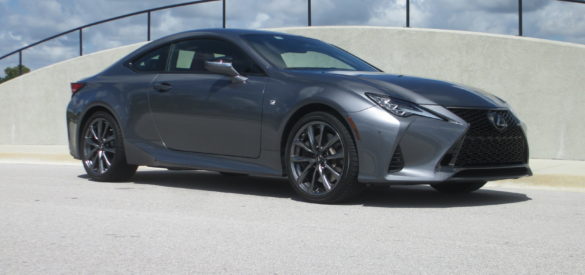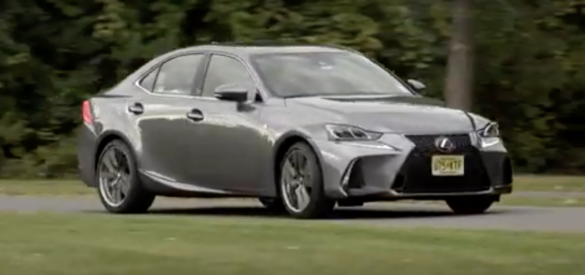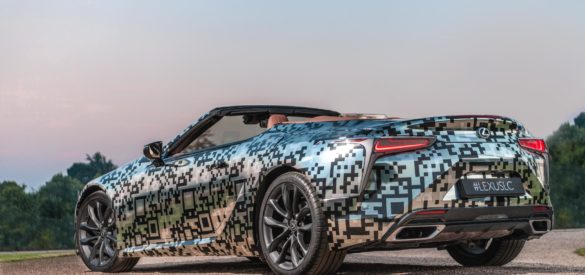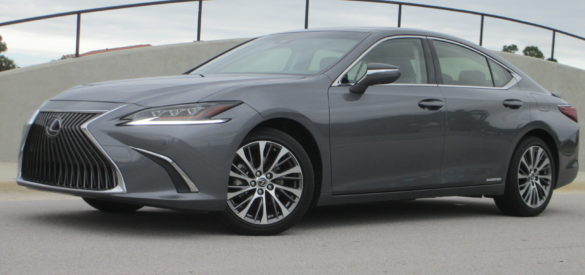2019 LEXUS RC 350 F SPORT QUICK TAKES
The idea of “sharper and more graceful” defines the LC flagship, so Lexus engineers have applied the same concept to the new RC. This included enhancing the car’s aerodynamics and fine-tuning the suspension system and powertrain. Armed with a more stable ride quality and sharper handling characteristics, the new RC is more athletic and responsive than ever.
Enhanced aerodynamics — such as a new fin shape on the side window mold and a duct on the rear bumper that improves air flow, result in improved stability. New available 19-in. wheels and tires with increased grip deliver excellent steering response. Stiffer suspension bushings have been incorporated along with new shock absorbers which provide significant damping force from low suspension stroke speeds. Thanks to a significant amount of real-world testing that allowed constant
fine-tuning by the chassis engineers, the new RC delivers an extremely supple ride quality and razor-sharp handling characteristics.
Lexus RC 300 rear-wheel drive is powered by a 2.0-liter turbocharged inline four-cylinder engine. This smooth operator produces 241 horsepower with 258 lb.-ft. of peak torque at 1,650-4,400 rpm. It’s paired with an eight-speed sport direct-shift automatic transmission with paddle shifters and consumes fuel at a rate of 21 mpg city / 30 mpg highway / 24 mpg combined manufacturer estimated fuel economy.
The RC 300 all-wheel drive has a 3.5-liter V6 engine. It produces 260 horsepower and 236 lb.-ft. torque at 2,000-4,800 rpm, and is teamed with a six-speed automatic transmission with paddle shifters. The RC 350 gets a 311-horsepower version of the V6. With rear-wheel drive, it gets the eight-speed Sports Direct Shift automatic transmission with paddle shifters; with all-wheel drive, it’s a six-speed automatic.
2019 Lexus IS 300 F SPORT AWD
Look at Lexus’s current vehicle offerings and like every automaker you’ll find standouts like the LS, LC, ES and then some real dogs like the GX, LX and well should we put the IS in that category too? Last redesigned for the 2014 model year it remains the cheapest way to get into a new Lexus sedan with a starting price of around $40,000. And in F SPORT livery it’s still turning heads! No saggy skin or bald spots, 6 years later and the IS looks as spry as ever. But appearances can be deceiving and as a long gaze turns into meaningful conversation the IS effuses a much different vibe.
Lexus states that this is a true sport sedan in every sense of the term with exhilarating performance – that I can guarantee you it is not, but that doesn’t mean it can’t be enjoyed.
LEXUS LC CONVERTIBLE PROTOTYPE UNVEILED
Lexus is to extend its exquisite LC flagship coupe range, with confirmation today that a dramatically styled open-top version is to go into production in the near future.
Visitors to this year’s Goodwood Festival of Speed in the UK will witness the world debut of an LC convertible prototype in action, when it appears on the famous hill course (July 4 to 7). The new model will take its place among some of the world’s most exclusive and prestigious new cars at the world-famous showcase for the finest modern and classic sports cars.
The future convertible sports coupe will broaden Lexus’ luxury lifestyle offerings, broadening the LC line-up and giving a sense of a completeness to the brand’s flagship models.
2019 LEXUS UX REVIEW
The model I’m running around in this week is the UX 200 Luxury with front-wheel drive and a handful of options leading to an MSRP of $41,560. As compared with the base UX, the Luxury adds a power rear hatch with kick sensor for hands-free operation, driver’s side memory settings, a blind spot monitor and much more to give its occupants a complete premium experience. Utilizing a new 2.0-liter 4-cylinder engine that delivers more power and better fuel efficiency than the Toyota powerplant, the UX is rated at 169 horsepower and 152 pound-feet of torque while using a trick CVT that’s engineered to behave more like a traditional automatic transmission with 10 simulated gears. In the urban environment for which it in intended, the driving experience is quite agreeable with enough grunt to move things along when needed, crisp steering and a chassis that profits from lightweight materials and a low center of gravity to imbue the UX with a dialed-in agility. The fully independent suspension delivers a welcome feeling of driver control while preserving a Lexus-level of comfort. It’s also quiet but not to the typically high Lexus standard…you’ll actually hear some road noise in here. It’s sized so neatly that maneuvering in traffic and finding suitable parking is a breeze…one of the best parts of owning a small car. And if the Cadmium Orange paint didn’t already awaken the senses this Glazed Caramel interior certainly will. It’s in here where this UX comes closest to earning its asking price – beautiful to the eye as well as the touch, with synthetic leather that is soft and feels like the real deal. It’s a driver focused cockpit with an optional heads-up display, cool graphics and a new twist on an old theme
LEXUS ES 300h 2019 QUICK TAKES
After nearly thirty years of success, the seventh-generation Lexus ES is set to redefine its status among entry-level executive sedans. Long known for its unparalleled comfort, refinement and luxury appointments, the 2019 Lexus ES builds on its strengths with an all-new chassis that allows for a more dynamic exterior design and the introduction of the first ES F SPORT. The introduction of the new Lexus ES continues the brand’s commitment to crafting vehicles with heightened excitement, emotion and passion. Traditional buyers will find the new ES more spacious and quieter while a new generation of customers will be introduced to a sedan with sharpened performance, advanced active safety technology and a level of craftsmanship rarely found in this segment. A new, fourth-generation Hybrid Drive System is used in the ES 300h. In addition to delivering stronger performance and exemplary fuel economy, the latest Hybrid Drive System has been designed to help eliminate the rubber band feeling associated with some hybrid systems.
An all-new 2.5-liter, four-cylinder gas engine (A25A-FXS) running on the Atkinson cycle is coupled with a smaller, more power dense electric motor and an all-new hybrid transaxle. The preliminary internal results are a combined 215 total system horsepower and a manufacturer estimated 44 combined mpg. The new aluminum-intensive gas engine delivers exceptional efficiency by combining a high-speed combustion design with several variable systems designed to conserve energy. The result is an engine that has a nearly identical displacement to its predecessor, yet delivers approximately 20 additional horsepower and 12 additional pound feet of torque. High-speed combustion is a core element of the new engine’s ability to provide the most efficient use of energy. To achieve this, the cylinder bores have been narrowed slightly (3.54 in. to 3.44 in.) and the stroke lengthened (3.86 in. to 4.07) to create an optimal 1:1.2 bore-to-stroke ratio as well as reducing the distance the fuel must travel to reach the edges of the cylinder. The angle between the valves was also increased to create a more direct path for the incoming air while the intake valve seats use a laser cladding process that allows for a larger valve seat area, reduced seat face temperatures and a smoother transition from the intake port to the combustion chamber. The result is an optimized swirl pattern and the ability to run more ignition advance in lean conditions without approaching knock limits.The new transaxle is over an inch (1.2) shorter than its predecessor thanks to a new arrangement of the electric motors that places them in a multi-axle configuration instead of the previous coaxial setup. The traditional planetary gear set has been replaced by a parallel shaft gear and a multi-function gear that incorporates a power split planetary ring gear, parking gear and counter drive gear into one compact unit.
The nickel-metal hydride battery that powers the electric motor has been relocated from the trunk to underneath the back seat. This was made possible by a 4.7-inch reduction in the height of the battery and the adoption of a more compact cooling system. Moving the battery under the seat not only frees up trunk space, it also improves the front-to-rear weight distribution of the ES for better handling.





